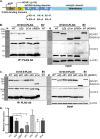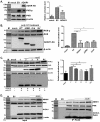Adenosine Deaminase Acting on RNA 1 Associates with Orf Virus OV20.0 and Enhances Viral Replication
- PMID: 30651363
- PMCID: PMC6430553
- DOI: 10.1128/JVI.01912-18
Adenosine Deaminase Acting on RNA 1 Associates with Orf Virus OV20.0 and Enhances Viral Replication
Abstract
Orf virus (ORFV) infects sheep and goats and is also an important zoonotic pathogen. The viral protein OV20.0 has been shown to suppress innate immunity by targeting the double-stranded RNA (dsRNA)-activated protein kinase (PKR) by multiple mechanisms. These mechanisms include a direct interaction with PKR and binding with two PKR activators, dsRNA and the cellular PKR activator (PACT), which ultimately leads to the inhibition of PKR activation. In the present study, we identified a novel association between OV20.0 and adenosine deaminase acting on RNA 1 (ADAR1). OV20.0 bound directly to the dsRNA binding domains (RBDs) of ADAR1 in the absence of dsRNA. Additionally, OV20.0 preferentially interacted with RBD1 of ADAR1, which was essential for its dsRNA binding ability and for the homodimerization that is critical for intact adenosine-to-inosine (A-to-I)-editing activity. Finally, the association with OV20.0 suppressed the A-to-I-editing ability of ADAR1, while ADAR1 played a proviral role during ORFV infection by inhibiting PKR phosphorylation. These observations revealed a new strategy used by OV20.0 to evade antiviral responses via PKR.IMPORTANCE Viruses evolve specific strategies to counteract host innate immunity. ORFV, an important zoonotic pathogen, encodes OV20.0 to suppress PKR activation via multiple mechanisms, including interactions with PKR and two PKR activators. In this study, we demonstrated that OV20.0 interacts with ADAR1, a cellular enzyme responsible for converting adenosine (A) to inosine (I) in RNA. The RNA binding domains, but not the catalytic domain, of ADAR1 are required for this interaction. The OV20.0-ADAR1 association affects the functions of both proteins; OV20.0 suppressed the A-to-I editing of ADAR1, while ADAR1 elevated OV20.0 expression. The proviral role of ADAR1 is likely due to the inhibition of PKR phosphorylation. As RNA editing by ADAR1 contributes to the stability of the genetic code and the structure of RNA, these observations suggest that in addition to serving as a PKR inhibitor, OV20.0 might modulate ADAR1-dependent gene expression to combat antiviral responses or achieve efficient viral infection.
Keywords: ADAR1; E3; Orf virus; PKR; Poxviridae; dsRNA; interferon.
Copyright © 2019 American Society for Microbiology.
Figures







Similar articles
-
Regulation of PACT-Mediated Protein Kinase Activation by the OV20.0 Protein of Orf Virus.J Virol. 2015 Nov;89(22):11619-29. doi: 10.1128/JVI.01739-15. Epub 2015 Sep 9. J Virol. 2015. PMID: 26355092 Free PMC article.
-
K160 in the RNA-binding domain of the orf virus virulence factor OV20.0 is critical for its functions in counteracting host antiviral defense.FEBS Lett. 2021 Jun;595(12):1721-1733. doi: 10.1002/1873-3468.14099. Epub 2021 May 27. FEBS Lett. 2021. PMID: 33909294
-
Double-stranded RNA deaminase ADAR1 promotes the Zika virus replication by inhibiting the activation of protein kinase PKR.J Biol Chem. 2019 Nov 29;294(48):18168-18180. doi: 10.1074/jbc.RA119.009113. Epub 2019 Oct 21. J Biol Chem. 2019. PMID: 31636123 Free PMC article.
-
Protein kinase PKR and RNA adenosine deaminase ADAR1: new roles for old players as modulators of the interferon response.Curr Opin Immunol. 2011 Oct;23(5):573-82. doi: 10.1016/j.coi.2011.08.009. Epub 2011 Sep 15. Curr Opin Immunol. 2011. PMID: 21924887 Free PMC article. Review.
-
The role of RNA editing enzyme ADAR1 in human disease.Wiley Interdiscip Rev RNA. 2022 Jan;13(1):e1665. doi: 10.1002/wrna.1665. Epub 2021 Jun 8. Wiley Interdiscip Rev RNA. 2022. PMID: 34105255 Free PMC article. Review.
Cited by
-
The Impacts of Reassortant Avian Influenza H5N2 Virus NS1 Proteins on Viral Compatibility and Regulation of Immune Responses.Front Microbiol. 2020 Mar 12;11:280. doi: 10.3389/fmicb.2020.00280. eCollection 2020. Front Microbiol. 2020. PMID: 32226416 Free PMC article.
-
Viral evasion of PKR restriction by reprogramming cellular stress granules.Proc Natl Acad Sci U S A. 2022 Jul 19;119(29):e2201169119. doi: 10.1073/pnas.2201169119. Epub 2022 Jul 11. Proc Natl Acad Sci U S A. 2022. PMID: 35858300 Free PMC article.
-
Orf Virus ORF120 Protein Positively Regulates the NF-κB Pathway by Interacting with G3BP1.J Virol. 2021 Sep 9;95(19):e0015321. doi: 10.1128/JVI.00153-21. Epub 2021 Sep 9. J Virol. 2021. PMID: 34287041 Free PMC article.
-
A tale of two proteins: PACT and PKR and their roles in inflammation.FEBS J. 2021 Nov;288(22):6365-6391. doi: 10.1111/febs.15691. Epub 2021 Jan 15. FEBS J. 2021. PMID: 33387379 Free PMC article. Review.
-
Effects of probiotic and yeast extract supplementation on oxidative stress, inflammatory response, and growth in weaning Saanen kids.Trop Anim Health Prod. 2023 Aug 2;55(4):282. doi: 10.1007/s11250-023-03695-0. Trop Anim Health Prod. 2023. PMID: 37530870
References
-
- Nandi S, De UK, Chowdhury S. 2011. Current status of contagious ecthyma or orf disease in goat and sheep—a global perspective. Small Rum Res 96:73–82. doi:10.1016/j.smallrumres.2010.11.018. - DOI
-
- McInnes CJ, Wood AR, Mercer AA. 1998. Orf virus encodes a homolog of the vaccinia virus interferon-resistance gene E3L. Virus Genes 17:107–115. - PubMed
Publication types
MeSH terms
Substances
LinkOut - more resources
Full Text Sources
Research Materials
Miscellaneous

